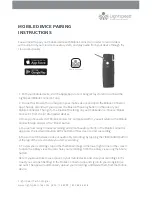
Copyright 2010-2013 Obihai Technology, Inc.
202
rb = Ringback Tone
ro = Reorder Tone (same as fast busy)
si1 – si4 = SIT TONE 1 – 4, respectively
st = Stutter Tone
0 – 9, *, #, a – d = DTMF 0 – 9, *, #, A – D respectively
Change Inter-digit Long Timer Dynamically After Partial Match
The OBi starts off with the inter-digit long timer set to the configured DigitMapLongTimer value when processing a new
digit sequence by a digit map. You may change the long timer as some patterns are partially matched by embedding the
syntax {L=<time>} within a rule in the digit map, where <time> is the desired number of seconds for the long timer. For
example:
(011 853 xxxx xxxx{L=5}x. |xx.)
Here the long timer is shortened to 5s after the user has entered 011 853 + 8 digits. Hence the OBi will declare that a
complete number is collected in 5s when no more digits are received. Without the {L=5} syntax the user will have to wait for
10s (by default) for the same to happen.
Note: This feature is not available on the OBi100/OBi110.
User Defined Digit Maps
Starting from release 1.2, there are 10 user definable digit maps available under the User Settings – User Defined Digit
Maps section of the device configuration web page. These digit maps are referred to as User Defined Digit Map 1 to 10.
Each user defined digit map is specified with 2 parameters:
-
Label: An arbitrary string for referencing this digit map in other digit map specification. The value should be 2-16
characters long. For example, “friends”. In this case, (Mfriends) can be referenced in other digit maps, such as
PHONE Port::DigitMap
-
DigitMap
By default both parameters are empty, except for User Defined Digit Map 1 (see the section below).
A User Defined Digit Map For IPv4 Dialing
The default values of the parameters for User Defined Digit Map 1 are set the following values to support IPv4 Dialing:
-
Label: ipd
-
Digit Map: (xx.<*:@>xx?x?<*:.>xx?x?<*:.>xx?x?<*:.>xx?x?|
xx.<*:@>xx?x?<*:.>xx?x?<*:.>xx?x?<*:.>xx?x?<*::>xx?x?x?x?)
The map (Mipd) is referenced in the default setting of the DigitMap in ITSP Profile A and B. It supports the following two
forms of IPv4 dialing:
a)
<user-id>*<a>*<b>*<c>*<d>
b)
<user-id>*<a>*<b>*<c>*<d>*<port>
where <user-id> is an arbitrary length numeric user-id, such as 100345, <port> is a port number in the range 0–65535, and
each of <a>,<b>,<c>,<d> is a 1-3 digit pattern in the range 1–255 that identifies one byte of an IP address. The dialed
Summary of Contents for OBi100
Page 54: ...Copyright 2010 2013 Obihai Technology Inc 54...
Page 55: ...Copyright 2010 2013 Obihai Technology Inc 55...
Page 58: ...Copyright 2010 2013 Obihai Technology Inc 58...
Page 75: ...Copyright 2010 2013 Obihai Technology Inc 75...
Page 100: ...Copyright 2010 2013 Obihai Technology Inc 100...
Page 109: ...Copyright 2010 2013 Obihai Technology Inc 109 SP1 SP2 SP3 and SP4 Services...
Page 126: ...Copyright 2010 2013 Obihai Technology Inc 126...
Page 135: ...Copyright 2010 2013 Obihai Technology Inc 135...
Page 140: ...Copyright 2010 2013 Obihai Technology Inc 140...
Page 157: ...Copyright 2010 2013 Obihai Technology Inc 157...
Page 158: ...Copyright 2010 2013 Obihai Technology Inc 158...
Page 159: ...Copyright 2010 2013 Obihai Technology Inc 159...
Page 174: ...Copyright 2010 2013 Obihai Technology Inc 174...
Page 185: ...Copyright 2010 2013 Obihai Technology Inc 185...
















































